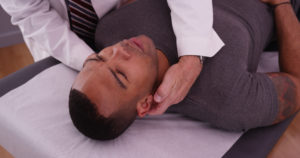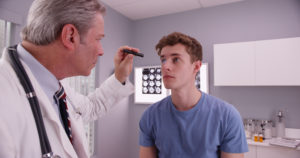A blow to the head may cause longer-term brain damage than previously thought and make it dangerous to drive a car even after concussion symptoms have subsided, a recent study of college students says.
The study at the University of Georgia examined 28 college students, half of whom had had a concussion two weeks earlier and half of whom had no injury. Researchers said subjects with concussions often had slower reaction times and scored lower on tests of thinking skills.
Drivers with concussions had slower reaction times than those without a head injury by an average of nearly one second, a UGA news release about the study says. Slowed reaction time is a predictor of crash risk, and split-second delays can be critical in avoiding a car accident.
The tests included simulations calling for split-second decision-making, including a child running in front of the car. The study participants with concussions took 0.03 seconds longer to react, which equated to 3 feet in stopping distance. Additionally, drivers were tested on their reaction to a stoplight. It took the drivers with concussions 0.24 seconds longer to react, an equivalent of nearly 16 feet in stopping distance, compared to drivers without concussions.
How Long to Wait Before Driving After a Concussion
“Our study suggests that complicated driving skills, the kind involving split-second reaction times that could mean the difference between life and death, are the ones that may take the longest to regain after you have a concussion — even when all of your symptoms have resolved,” Julianne Schmidt, co-director of the UGA Concussion Research Lab, says in the news release.
Schmidt found similar results in a 2017 study of 14 college-age participants who were tested on a driving simulator within 48 hours after they no longer felt the effects of their concussions. That study was published by the Journal of Neuroscience. The newer study was presented at a virtual meeting of the American Academy of Neurology in August and awaits peer review, according to U.S. News & World Report.
In a 2018 study, Schmidt found that a majority of student-athletes did not refrain from driving at any point following their previous concussions despite generally believing that driving immediately following a concussion is unsafe.
Signs of Concussion
A concussion is a mild form of traumatic brain injury (TBI). Concussions are usually caused by a blow to the head, such as in a fall, contact sports or an assault. Violent movement of the head, caused by events such as a car accident collision or being shaken, can cause a brain injury.
Most people fully recover from a concussion after several weeks of reduced activity.
The Mayo Clinic says common symptoms after a concussive TBI are headache, loss of memory (amnesia) and confusion. The amnesia usually involves forgetting the event that caused the concussion.
A person may have some symptoms of concussions immediately, and some can occur for days after the injury.
Signs and symptoms of a concussion may include:
- Headache
- Ringing in the ears
- Nausea
- Vomiting
- Fatigue or drowsiness
- Blurry vision
- Confusion or feeling as if in a fog
- Amnesia surrounding the traumatic event
- Dizziness or “seeing stars”
- Dazed appearance
- Slurred speech
- Delayed response to questions
- Forgetfulness, such as repeatedly asking the same question
- Concentration and memory problems
- Irritability and other personality changes
- Sensitivity to light and noise
- Sleep disturbances
- Psychological adjustment problems and depression
- Disorders of taste and smell.
Is Driving After a Concussion Like Driving Under the Influence?
In her 2017 study, Schmidt found that, even though participants felt like they had recovered from their concussion, they were still likely to drive erratically when using a driving simulator. Their reactions at times were similar to someone driving under the influence of alcohol.
“They had less vehicle control while they were doing the driving simulation, and they swerved more within the lane,” Schmidt said. “This is a pretty large indicator of motor vehicle accident risk, and this is at a time point when they are considered recovered.”
The Concussion Institute referred to Schmidt’s 2017 study and said her researchers also compared their results to those of individuals with neurological diseases like Parkinson’s and multiple sclerosis. The Institute cited an academic study in Australia that showed that individuals who had suffered a concussion have a harder time identifying hazards on the road.
How Long After a Concussion Is It Safe to Get Back Behind the Wheel?
As is often the case after academic research, further study is needed to determine how to apply what has been learned. Schmidt has not developed a timeline for driving after a concussion. After one study, she said post-concussion driving restrictions could deter the injured from seeking medical help.
A Canadian researcher and medical practitioner commenting for the Ottawa Citizen’s lengthy examination of Schmidt’s 2017 study said he usually tells patients they can drive after a concussion or other more serious brain injury. But he also reminds patients that they are responsible for being fit to drive.
Dr. Shawn Marshall, head of physical medicine and rehabilitation at the Ottawa Hospital and a researcher with the University of Ottawa Brain and Mind Research Institute, compared concussion impairments to those for alcohol or marijuana: Having a drink or (in Canada) smoking a joint is legal, but an individual is temporarily impaired from driving because they’ve decided to do that.
Immediately after a concussion, an individual is not fit to drive, Marshall said.
A concussion impairs the individual in three cognitive areas relevant to driving:
- Information-processing speed, or how quickly they take in information and use it
- Dividing their attention between tasks, like checking the speedometer then looking down the road and then refocusing on the rear-view mirror
- Ability to focus.
Driving requires the ability to multi-task and take in information quickly.
Marshall pointed out that new protocols for concussion recovery are to re-introduce activity slowly as tolerated, instead of prescribing complete rest. Marshall compared recovery from concussion to recovering from a sprained ankle: If you can walk without pain, proceed but, if walking causes pain, back off temporarily before trying again.
For driving, a 10-minute commute might be OK, but not a long vacation trip, he said.
“Obviously, if the person is acutely confused and doesn’t know the date or doesn’t know where they are, they shouldn’t be driving,” he said.
Contact a Car Accident Attorney
If you have been injured in a car accident that was caused by a driver who had recently suffered a concussion, their injury could explain the car crash. You should not be left with medical debts for a car accident caused by another driver. In Kentucky, Morgan, Collins, Yeast & Salyer will investigate to determine the cause of the car accident that injured you and move aggressively to recover the compensation you deserve to have.
Contact us online or at (877) 809-5352 today. At Morgan, Collins, Yeast & Salyer, we can provide the Kentucky Courage you need to get through this tough time.
The post Studies Show Drivers Should Wait to Drive After Suffering a Concussion appeared first on Morgan, Collins, Yeast & Salyer.
from Morgan, Collins, Yeast & Salyer https://www.kentuckycourage.com/blog/studies-show-drivers-should-wait-to-drive-after-suffering-a-concussion/
via https://www.kentuckycourage.com


 and legal knowledge and experience to work for you.
and legal knowledge and experience to work for you.
